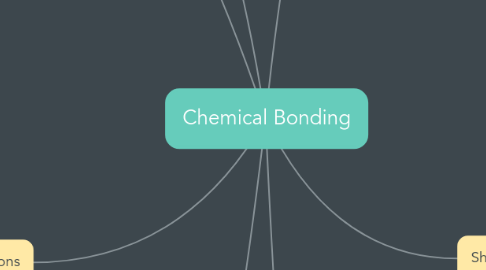
1. Instantaneous dipole-induced dipole forces (id-id) (London dispersion forces)
1.1. the weakest intermolecular attractive force. It results from temporary instantaneous dipoles induced in both polar and non-polar molecules. These forces are also called London dispersion forces. The dipoles are not permanent. In this context, ‘induced’ means that one molecule brings about an attractive or repulsive effect on another.
2. Intermolecular forces
2.1. Permanent dipole-permanent dipole (pd-pd)
2.1.1. attractive intermolecular forces which result from permanent dipoles in molecules
2.2. Hydrogen bond (special case of permanent dipole-permanent dipole (pd-pd) forces)
2.2.1. the strongest type of intermolecular force but weaker than covalent bonds. It is a strong type of pd-pd force.
3. Definitions
3.1. intermolecular forces
3.1.1. the weak forces between molecules
3.2. lone pairs (of electrons)
3.2.1. pairs of electrons in the outer shell of an atom that are not involved in bonding
3.3. electron deficient
3.3.1. an atom or molecule that has less than its usual share of electrons
3.4. bond energy
3.4.1. the energy required to break one mole of a particular covalent bond in the gaseous state.
3.5. bond length
3.5.1. the distance between the nuclei of two covalently bonded atoms
3.6. electronegativity
3.6.1. the power of a particular atom that is covalently bonded to another atom to attract the bonding pair of electrons towards itself.
3.7. polar bonds
3.7.1. the electron pair in the bond is drawn towards the atom with the larger electronegativity, making one end of the molecule slighly positive compared with the other.
3.8. bond polarity
3.8.1. the partial separation of charge when two different atoms are joined by a covalent bond. This results in an unequal attraction for the bonding pair of electrons.
4. Sources
4.1. Chemistry for Cambridge International AS & A Level Coursebook by Lawrie Ryan & Roger Norris (Third edition)
4.2. Chemistry notes
5. Types of chemical bonding
5.1. Ionic bonding
5.1.1. the electrostatic attraction between oppositely charged ions (cations and anions)
5.2. Covalent bonding
5.2.1. the electrostatic attraction between the bonding electrons and two positive nuclei
5.3. Metallic bonding
5.3.1. the electrostatic attraction between positive ions and delocalised electrons
6. Shapes of molecules
6.1. Tetrahedral
6.1.1. 4 bonding pairs, 0 lone pairs, 109.5°
6.2. Pyramidal
6.2.1. 3 bonding pairs, 1 lone pair, 107°
6.3. V shape
6.3.1. 2 bonding pairs, 2 lone pairs, 104.5°
6.4. Linear
6.4.1. 2 bonding pairs, 0 lone pairs, 180°
6.5. Trigonal planar
6.5.1. 3 bonding pairs, 0 lone pairs, 120°
6.6. Trigonal bipyramidal
6.6.1. 5 bonding pairs, 0 lone pairs, Three 120° and two 90°
6.7. 6 bonding pairs, 0 lone pairs, 90°
6.8. Octahedral
7. σ (sigma) bonds and π (pi) bonds
7.1. Sigma (σ) bonds
7.1.1. Sigma bonds are formed from end-on overlap of atomic orbitals.
7.2. Pi (π) bonds
7.2.1. Pi bonds are formed ftom sideways overlap of atomic orbitals.
7.3. Sigma and pi bonds in shapes of molecules
7.3.1. Single bond = 1 sigma bond
7.3.2. Double bond = 1 sigma bond and 1 pi bond
7.3.3. Triple bond = 1 sigma bond and 2 pi bonds
